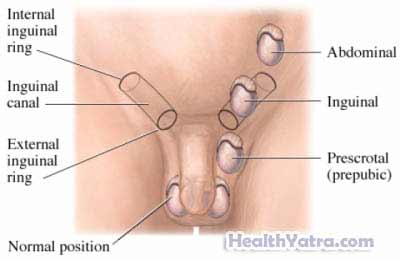Undescended Testes Treatment Cost in India
A child’s testicles develop before birth. They start inside the abdomen. The testicles should then move down into the scrotum just before birth. Undescended testes stay in or return to the abdomen. A “true” undescended testicles situation is present at birth. The testicle remains in the abdomen until treated. Other situations that allow the testicles go up into the abdomen include:
- Retractile testicles—the testicles can move freely between the scrotum and abdomen. This condition does not require treatment and usually disappears by puberty.
- Ascending testicles—a normal testicle returns to the abdomen

Causes
Undescended testicles are often caused by a disruption in the development of the testicles. The cause of this disruption is not clear. Genetics may play a role. There may also be some problems with the hormones that help testes develop. The testicles may also have been injured at some point during the pregnancy.
Risk Factors
Factors that may increase your child’s risk of undescended testicles include:
- Prematurity
- Low birth weight
- Twin gestation
- Down syndrome (fetus) or other chromosomal abnormality
- Gestational diabetes mellitus
- Prenatal alcohol exposure
- Hormonal abnormalities (fetus)
- Toxic exposures in the mother
- Having a mother younger than 20
- A family history of undescended testes
Symptoms
The main symptom is not being able to see or feel the testicle. With retracting or ascending testicles, your child’s testicle may disappear.
Diagnosis
Your doctor will ask about your symptoms and medical history. A physical exam will be done. A diagnosis is usually made during the physical exam. The doctor will note that one or both of the child’s testes cannot be felt within his scrotum. Additional tests may include the following:
- MRI scan—a magnetic resonance scan to create detailed images of the testes
- CT scan—specialized x-ray to create detailed images of the testes
- Laparoscopy—a surgical procedure that uses a tiny camera to see inside the abdomen
Treatment
Undescended testicles are treated because they can increase the risk of certain health conditions such as:
- Infertility or low fertility—a testicle is more likely to produce sperm in cooler temperature as in the scrotum, the heat inside the body is too high for sperm production.
- Testicular cancer
- Torsion—testicles twist enough so that they cut of the blood flow to the testes. This can cause severe damage to the testicles.
- Emotional distress—as the child ages, they may have problems with the appearance of the empty scrotum.
Talk with your doctor about the best treatment plan for your child. Treatment options include:
- Giving the problem time to go away on its own:
- In most children, the testes will descend on their own by four months of age.
- Retractile testicles will completely descend at puberty. Further treatment is not needed.
- Hormone therapy with human chorionic gonadotropin (HCG) :
- This treatment is not used often.
- The hormone helps stimulate testicle development. This may encourage the testicle to move down, as it should.
- Surgery called orchiopexy:
- This is done while your child is asleep under anesthesia.
- It is often done with laparoscopic surgery. The doctor will only need to make tiny incisions in the area.
- The testicle is moved down and stitched into place.
Prevention
There is no known way to prevent undescended testes.
